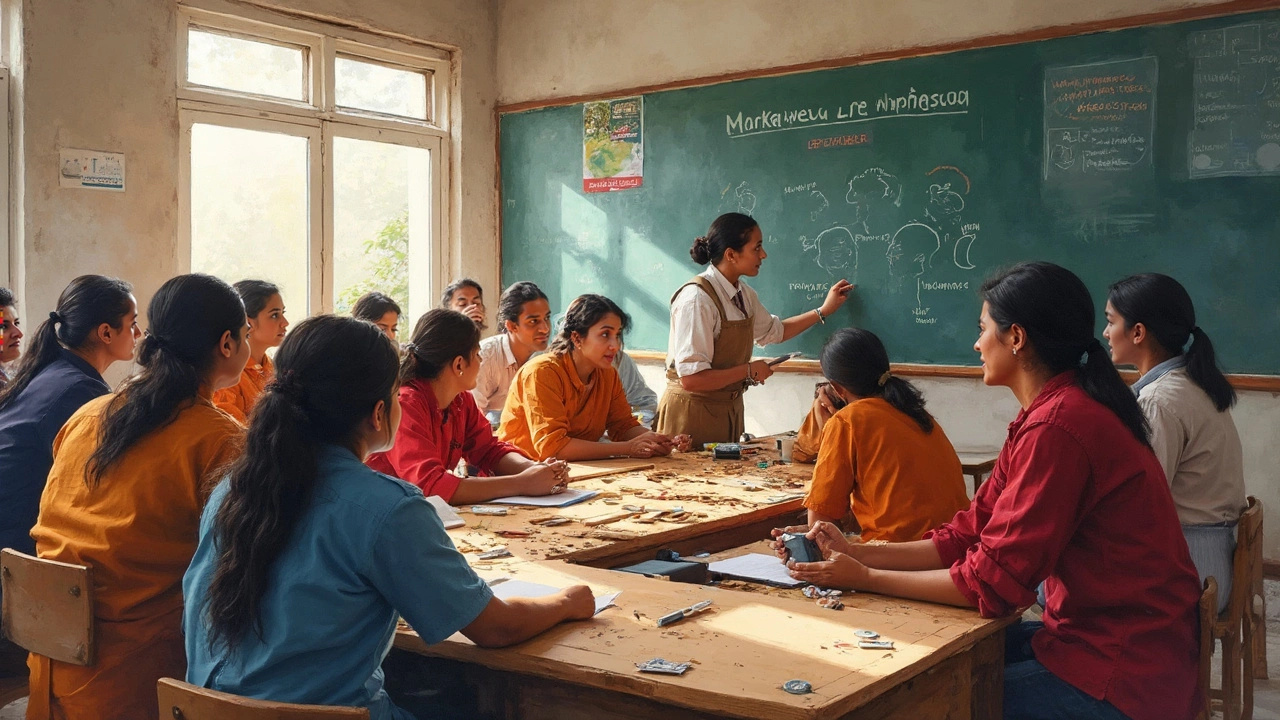
Ever heard someone say learning a trade after 40 isn’t possible? That’s just noise. In India right now, there’s a huge push for skilled workers, and trade courses aren’t checking your birth certificate before handing you a seat. The average age in trade classrooms keeps rising—no one blinks if you’ve already celebrated the big four-oh.
Honestly, if you’re at a life stage where you’re thinking of switching careers, you’ve got something many younger folks don’t: actual work and life experience. That means you probably know what you’re good at, what bores you, and how to spot an empty promise from a real opportunity. You’ve learned how to stay focused and juggle family, bills, maybe even a stubborn cat like mine.
Let’s cut to the chase—if you’re wondering whether you’ll be the odd one out in trade courses, stop. Many institutions now run evening or weekend trade programs tailored for adult learners. Government ITIs, private academies, even some online options are updating their programs for people who are tired of their old 9-to-5 or just want a practical, in-demand skill.
- Why 40 Isn’t a Deadline
- Big Myths About Age and Trades
- Which Trades Welcome Older Learners
- How to Pick the Right Trade Course
- Tips for Studying and Standing Out at 40
- Success Stories: Making the Leap Mid-Life
Why 40 Isn’t a Deadline
So many people worry that hitting 40 means doors start closing. But look around—plenty of folks are jumping into new careers at this very age, especially in skilled trades. In places like India, there’s actually a steady demand for workers who have common sense, reliability, and the patience to hit the books again. If you think employers only want 20-somethings, check the job boards—there are thousands of trade roles in places like Pune, Delhi, and Chennai asking for experience and maturity, not just a fresh diploma.
Here’s something eye-opening: according to a 2024 NSDC report, almost 30% of people enrolling in trade courses India are above 35. Makes sense, right? Trade skills don’t have an age limit, and customers often trust older professionals with jobs like electrical work, plumbing, or carpentry. In many training centers, instructors even prefer learners who aren’t just there because their parents told them to sign up.
| Age Group | Percentage |
|---|---|
| 18-24 | 41% |
| 25-34 | 29% |
| 35-44 | 18% |
| 45+ | 12% |
What’s even better, many training centers and ITIs are running fast-track or flexible courses geared for older learners who need to balance work and family. These programs skip the filler and focus right on hands-on skills so you can hit the ground running. Here’s what helps older learners in these courses:
- Evening or weekend sessions for those with day jobs.
- Shorter certifications (6-12 months) for switching careers quick.
- Peer networks and WhatsApp groups—you’ll often find yourself surrounded by others with kids, mortgages, and grey hairs.
Age might bring a few backaches, but it also brings focus, grit, and the ability to handle setbacks with a cool head. That’s exactly what makes people in their 40s a great fit for learning a trade right now.
Big Myths About Age and Trades
People love to talk, and there’s nowhere they chatter more than about what you “can” or “can’t” do after a certain age. When it comes to learning a trade at 40, the myths get pretty wild. Let’s break down the biggest ones, and why they’re more rumor than reality.
- Myth 1: You’re Too Old to Compete With Younger Folks
This one comes up all the time. But fact is, a lot of skill development centres and trade schools in India report that their student batches are now full of people over 30—and plenty over 40. It turns out, experience handling real-life situations actually helps. As Mr. S.K. Sharma, a senior instructor at a Delhi trades institute, puts it:“Older students often have more focus and discipline. They take training seriously and are more likely to stick with it.”
- Myth 2: Trades Are Just for School Dropouts
Nope. These days, everyone from engineers to MBAs to homemakers is signing up for trade courses. The National Skill Development Corporation (NSDC) reports a jump in graduates joining skilled trades—especially folks looking for stable or hands-on jobs. Degrees are great, but practical skills run the world. - Myth 3: Employers Want Only the Young
Plenty of Indian companies—especially in construction, electrical, plumbing, welding, and automotive tech—don’t care if you’re 25 or 45. What matters is if you can do the job. There’s actually a skills shortage right now, and employers tend to value maturity and reliability more than just a fresh face. - Myth 4: Learning Is Tougher as You Age
Science says the real problem isn’t age, it’s whether you practice. Studies from IIT Madras found that adults can learn hands-on skills fast—sometimes faster than young freshers—because they know how to organize their learning and aren’t scared of making mistakes.
The bottom line? The old stories about being too late for a new career in skilled trades don’t line up with how things work in the real world. If you’re serious, “learn a trade at 40” is not just possible—it’s starting to be the new normal.
Which Trades Welcome Older Learners
If you’re thinking, “Okay, but which trades let someone at 40 start fresh?”—good question. Not every trade cares about your age. In fact, some fields in India actively look for older beginners, because they trust people who show up ready to grind, focus, and stick with the work.
Here are some trades where folks in their 40s regularly get in and do well:
- Electrician: Training is hands-on and most ITI programs don’t care about your age—as long as you pass the entrance and medical fitness.
- Plumbing: Plumbers are in short supply especially in cities. The job relies on problem-solving skills (something you’re probably better at after 20+ years working and living!).
- Welding and Fabrication: Factories and repair shops need skilled welders. Many short-term certificate courses accept adults, and job placements are common.
- Automotive Technician: With India’s car and bike market growing, there’s ongoing demand for certified mechanics. Experience around engines (even as a hobbyist) is a plus.
- Air Conditioning and Refrigeration: Cooling tech is everywhere now—homes, malls, offices. ITIs and private centers train adults in less than a year.
- CNC Machine Operator: Manufacturing jobs need machine operators more than ever, and older candidates are trusted for their reliability in factories.
- Health and Safety Technician: These roles value life experience, because safety is serious business. Courses like fire safety or industrial protection are open to all ages.
Just so you can see the numbers, here’s what job demand and average course duration look like for a few of India’s trending trades:
| Trade | 2024 Job Openings (Lakhs) | Typical Course Duration |
|---|---|---|
| Electrician | 2.1 | 1-2 years |
| Plumbing | 1.2 | 6-12 months |
| Welding | 0.9 | 6-18 months |
| Automotive Technician | 1.0 | 1 year |
| Refrigeration & AC | 0.7 | 6-12 months |
If you’ve already built up people skills, project management chops, or just have more patience than you did at 20, trades like electrical work or health and safety actually want you. Bonus: in most admissions, no upper age limit holds you back—ITI and private trade schools in India are openly letting in older students if you meet basic education and health standards. This means you’re not boxed out just because you’ve already seen a couple decades of office life or business grind.

How to Pick the Right Trade Course
If you’re 40 and thinking about a trade, you want to make a smart choice right from the start. So, how do you actually find a course that fits your needs, your schedule, and your bank balance?
First, focus on what’s in demand. According to the India Skills Report 2024, fields like electrical work, plumbing, welding, AC technician, and digital trades (like computer hardware repair) are hiring like crazy. You don’t want to invest time and money in a field where jobs are drying up.
- Check job portals and local classifieds—see which skills keep popping up.
- Talk to people actually working in those trades. They’ll give you the lowdown that course brochures won’t.
- Ask about average salaries. For example, a qualified electrician or AC mechanic in metro cities can earn between ₹22,000 - ₹45,000 per month, especially if you go independent.
Then, look at the course structure and teaching style. Pick something that offers more than just theory. You want hands-on training, projects, and maybe even an internship. ITIs (Industrial Training Institutes) and top private academies now often blend classroom time with real-world work. That’s massive for building your confidence from day one.
| Trade | Duration | Average Starting Salary (per month) | Hands-On Training? |
|---|---|---|---|
| Electrician | 2 years | ₹22,000 | Yes |
| Plumber | 1 year | ₹18,000 | Yes |
| Welding Technician | 1 year | ₹19,000 | Yes |
| AC Technician | 6 months | ₹24,000 | Yes |
| Computer Hardware Repair | 6 months | ₹21,000 | Yes |
Don’t ignore timing and flexibility. If you need to work while you’re studying, pick courses in the evenings or weekends. More places than ever—especially government ITIs—offer this because they know not everyone is a full-time student. Some even offer hybrid setups, mixing online and offline classes.
- Compare fees, but don’t jump at the cheapest course. Check reviews. If their ex-students are actually getting jobs, it’s a good sign.
- Look at location. If you live in a tier-2 or tier-3 city, see if there’s a local skills centre or PMKVY (Pradhan Mantri Kaushal Vikas Yojana) offering the course you want.
- Certification matters. For big industries or government jobs, they want to see a recognized certificate—like NCVT or SCVT, which are standard in India.
Bottom line: a learn a trade at 40 plan pays off if you pick a course that blends skill, demand, and flexibility. Focus on smart choices, not just the shiny brochure. Your decision now sets up the next chapter—so make it count.
Tips for Studying and Standing Out at 40
The big question: how do you actually thrive in a trade course when you’re not the youngest in the room? Turns out, your age can be a secret weapon. You’ve been through life’s ups and downs, so you already have discipline, patience, and people skills baked in. Most 40-year-olds aren’t afraid to ask questions and get straight to the point. That’s a huge plus in a practical classroom.
Here are some concrete ways to set yourself apart while studying a trade at 40 or older:
- Use your life experience. Bring real-world examples into class discussions. For instance, if you managed teams or ran your own small business, you’ll find project work and teamwork pretty familiar.
- Set a routine. Consistency is everything. Even twenty minutes a day to review what you learned can make a difference. Block study time on your calendar like it’s an important meeting (because it kind of is).
- Don’t hesitate to tap into tech. Most trade courses in India are getting digital. Download videos, PDFs, or even trade apps to brush up on concepts. Apps like Unacademy, Coursera, or even simple WhatsApp groups have become gold mines for clearing doubts.
- Ask for help early. Most trade faculty value mature students’ commitment, so they’re willing to explain something twice. Don’t let pride get in the way.
- Network with classmates. Whether they’re 18 or 50, building those contacts helps—sometimes a younger peer can explain a trick, or you can help someone else with basics.
- Keep your end goal in sight. Whether it’s a steady job, a promotion, or opening your own business, remind yourself why you started. It gets you through tough weeks.
A quick look at some numbers can help you see you’re not alone. Check these real stats from a 2024 study by the National Skill Development Corporation (NSDC) on adult learners in Indian trade courses:
| Age Group | % of Total Trade Course Students | Placement Rate Within 6 Months |
|---|---|---|
| 18-25 | 56% | 74% |
| 26-35 | 26% | 78% |
| 36-45 | 12% | 80% |
| 46 and above | 6% | 77% |
Notice that adults in the 36-45 range (and even those above 46) have higher or similar placement rates compared to the youngest crowd. Employers love experience mixed with new skills. So when you wonder if you can really stand out, remember: the odds are already stacked in your favour if you play to your strengths and stay consistent. That’s how you make your mark in the learn a trade at 40 game.
Success Stories: Making the Leap Mid-Life
People often think learning a trade at 40 is risky, but real stories blow that idea out of the water. Across India, thousands have switched from office jobs, sales, or running small businesses to new trades after their fortieth birthday. For some, it was about wanting job security. For others, it was the need for a fresh start or a better paycheck.
Take Pradeep Patil from Pune. He worked in customer support until he was 42. After he got laid off during the pandemic, he signed up for an electrician trade course at his local ITI. Less than a year later, Pradeep had his own small electrical repair business and started earning more than before. He now takes on residential and shop work and has even started training two assistants.
Or look at Neelam Sharma from Lucknow. She spent over 15 years in the textile retail sector. At 45, she joined a government-funded plumbing course. Within six months, she was interning on large commercial plumbing projects. Her trainers said her previous management skills made her stand out for top jobs. Now, Neelam mentors new women trainees looking to break stereotypes in trades.
Some trade programs are even reporting that over 30% of their new applicants are above the age of 35. Here’s a quick look at recent stats from a few top Indian vocational institutes:
| Institute/Trade | Percent of Students 35+ | Popular Courses |
|---|---|---|
| Delhi ITI | 28% | Electrician, Welder, Plumber |
| Bangalore Government TTI | 33% | Automobile Mechanic, Refrigeration |
| Mumbai MITC | 35% | AC Technician, Fitter |
It’s not just about jobs—some even grow into trainers, business owners, or contractors. They’re living proof: learning a trade at 40 in India is not some wild gamble. It’s a practical move with real upside, especially when backed by hard data and real-life wins.
